Simple Gravity Experiments
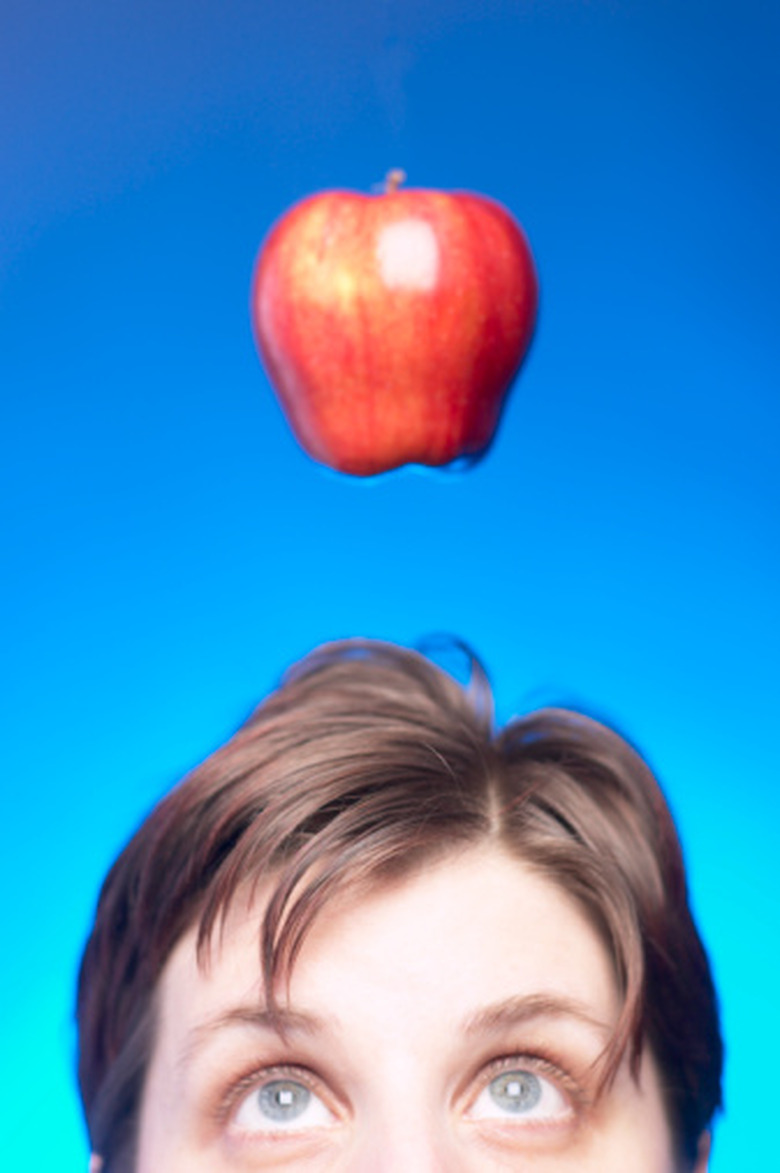
Gravity is a fundamental part of nature that keeps our feet planted firmly on the ground. This unseen force is responsible for tides, keeping Earth from careening into the darkness of space, and for causing food to hit the kitchen floor when it slips from your hand. Though invisible, gravity's effects can be observed by performing simple and easy-to-do experiments.

Galileo's Experiment
Named after the scientist who is popularly believed (though not verified) to have performed this experiment, it involves taking two objects of different sizes and weights and dropping them to see which one hits the ground first. As the Earth's gravity affects objects at the same rate regardless of their weight, without air resistance the objects should hit the ground at the same time. Try this with different objects with varying weights and air resistance and observe its effects.
The Spinning Bucket
Showing the relation between motion and gravity, for this experiment you need a bucket with water and someone with a strong arm to spin it. In theory, when the bucket turns upside down the water should come spilling out as gravity pulls it downwards. Spinning it fast enough, the water tends to keep going in a straight line, counteracting the pull of gravity and thus wedging it to the end of the bucket, preventing the natural pull of gravity from spilling the water. This is why this effect, called "centrifugal force" is often referred to as artificial gravity.
The Hole in the Cup
For this experiment you need a paper cup and some water. Poke a hole in the cup and cover it with a finger; fill the cup with water. Take your finger from the hole and notice the water spills out. Though gravity pulls down both objects, only water moves freely (because you're holding the cup); thus, gravity forces the water out. Fill the cup again and drop it to the ground. Now that both objects are free to move, they drop at the same speed so the water isn't forced out of the hole.
Center of Gravity
A center of gravity experiment can be done quite easily; all that is required is a pencil or pen and your finger. Try to balance the pen at different positions on your finger until you reach the point where it doesn't fall off. This is the center of gravity of the pen, the point in which its weight averages out and, if it were in a weightless environment, the point at which it can freely rotate. Put on the cap and try to balance it again. As the weight of an object changes, so does its center of gravity.
- Kids Science Experiments: Spinning Bucket of Water
- Discovery Channel: Gravity Gets You Down
- NASA: Center of Gravity
Cite This Article
Johnson, Steve. "Simple Gravity Experiments" sciencing.com , https://www.sciencing.com/simple-gravity-experiments-8555558/. 24 April 2017.
Johnson, Steve. (2017, April 24). Simple Gravity Experiments. sciencing.com . Retrieved from https://www.sciencing.com/simple-gravity-experiments-8555558/
Johnson, Steve. Simple Gravity Experiments last modified March 24, 2022. https://www.sciencing.com/simple-gravity-experiments-8555558/
Recommended
Get Your ALL ACCESS Shop Pass here →

Easy Gravity Experiments For Kids
Why do things fall to the ground when you let go of them? It’s all to do with gravity! Learn about what gravity is with a simple definition and everyday examples of gravity. Explore simple physics with easy, hands-on experiments kids will love. From falling objects, balancing apples, and even an egg drop challenge, enjoy these fun gravity science projects for kids!
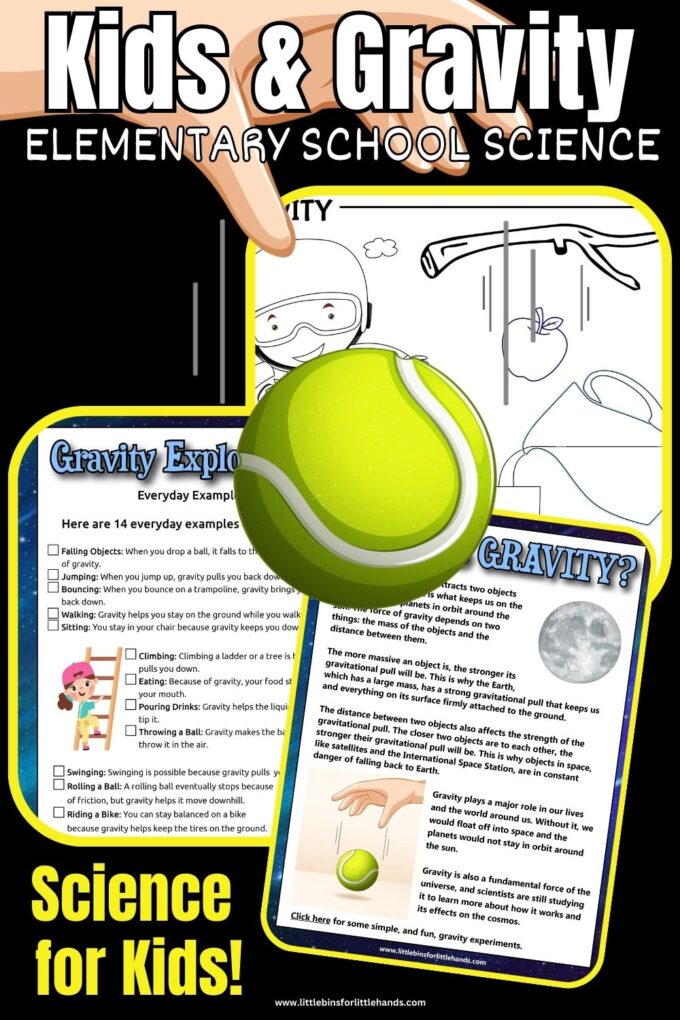
What is Gravity?
Gravity is a force that pulls objects toward each other. It’s why things fall to the ground when you drop them. On Earth, gravity pulls everything toward the planet’s center, so we stay on the ground instead of floating into space!
Gravity also keeps the planets in our solar system orbiting around the sun. The bigger something is, the stronger its gravity. So, Earth’s gravity is much stronger than the gravity of a small object like a ball, but not as strong as the sun’s gravity. Gravity affects everything around us, even though we can’t see it!
Have you ever watched a NASA video of an astronaut floating around inside his/her ship?
Galileo and Gravity
Galileo Galilei was a famous scientist who helped us understand how gravity works. He discovered that gravity is a force that pulls objects down toward the ground.
One of his famous experiments was when he dropped two objects of different weights from the Leaning Tower of Pisa to see if they would fall at the same speed. To everyone’s surprise, they did!
Galileo showed that gravity pulls all objects equally, no matter how heavy. This idea changed the way people thought about gravity and led to many important discoveries about how things move.

Ball Drop Experiment
- Two objects of different weights (like a small ball and a larger book)
- A chair or a step stool (to stand on safely)
What to do:
- Stand on the chair or stool (make sure you’re being safe!).
- Hold the two objects—one in each hand—at the same height.
- Drop both objects at the same time.
- Watch closely! Did they hit the ground at the same time?
What happens: Just like in Galileo’s experiment, you’ll see that both objects, even though they have different weights, should fall and hit the ground at the same time. This shows that gravity pulls objects to the ground at the same rate, no matter how heavy they are!
Everyday Examples of Gravity
Here are 15 everyday examples of gravity that are easy for kids to understand:
- Falling Objects: When you drop a ball, it falls to the ground because of gravity.
- Jumping: When you jump up, gravity pulls you back down to the Earth.
- Walking: Gravity helps you stay on the ground while you walk.
- Sitting: You stay in your chair because gravity keeps you down.
- Climbing: Climbing a ladder or a tree is harder because gravity pulls you down.
- Bouncing: When you bounce on a trampoline, gravity brings you back down.
- Swinging: Swinging on a swing set is possible because gravity pulls you back towards the Earth.
- Driving: Your car stays on the road because of gravity.
- Eating: Because of gravity, your food stays on your plate and in your mouth.
- Pouring Drinks: Gravity helps the liquid flow from a cup when you tip it.
- Throwing a Ball: Gravity makes the ball come back down after you throw it in the air.
- Rolling a Ball: A rolling ball eventually stops because of friction, but gravity helps it move downhill.
- Riding a Bike: You can stay balanced on a bike because gravity helps keep the tires on the ground.
- Water Flow: Water flows downhill because of gravity, which is why rivers and streams exist.
- Kite Flying: Gravity keeps the kite from flying too high, and the tension in the string is balanced by gravity pulling it downward.
Can you think of any more examples of gravity?
Free Gravity Information and Activity Pack
Get up and test gravity for yourself with a free gravity activity pack ! Share this information guide, quick activity, and gravity coloring sheet with your kids!
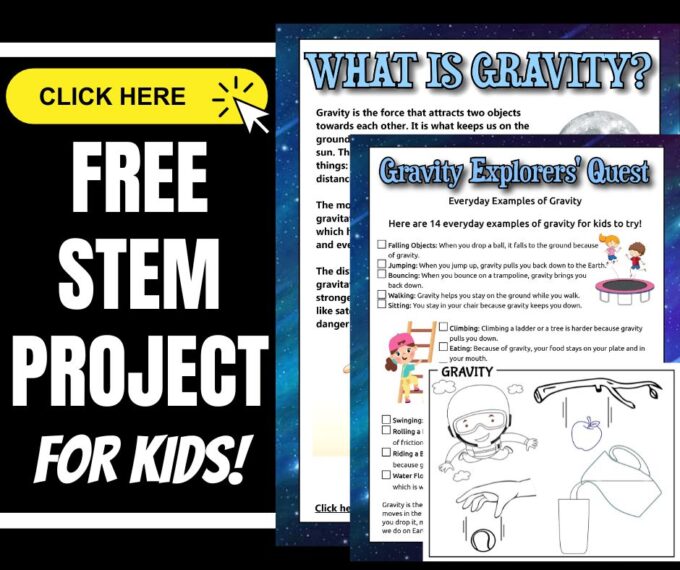
12 Gravity Experiments To Try
Here are 12 gravity science experiments that are great for elementary school kids. Learn about gravity and its effects in a fun and hands-on way.
You may also want to explore: Air Resistance Projects
Dropping Objects
Gather various objects of different weights and sizes (e.g., a feather, a paperclip, a small ball). Have kids predict which object will hit the ground first when dropped simultaneously and then test their predictions.
Paper Airplane Challenge
Have kids create paper airplanes of different sizes and shapes. Let them fly the planes and observe how gravity affects their flight paths differently based on their designs. See how to make a paper airplane launcher.

Falling Rates
Use a ruler or a measuring tape to drop different objects from the same height and measure the time it takes for them to reach the ground. Compare the falling rates of various objects.
Balloon Rocket
Attach a string to a balloon and tape the other end to a straw. Inflate the balloon and then release it. Observe how the air escaping from the balloon propels the straw in the opposite direction due to Newton’s Third Law of Motion.

Coin and Card Drop
Place a playing card on the edge of a table and let half of it hang over the edge. Hold a coin over the card’s hanging part and let it go. The card will fall due to gravity, but the coin’s rapid descent might surprise the kids as they learn about mass and air resistance .
Design A Parachute
Explore how mostly the forces of gravity and air resistance (also known as drag), slow down the descent of an object or person using a simple parachute. Vary the shape, size or material of the parachute and measure what happens.
Build A Pipeline
Make your own pipeline that will transport water from the main tank to a smaller tank using an incline. Observe how the moves because of gravity.
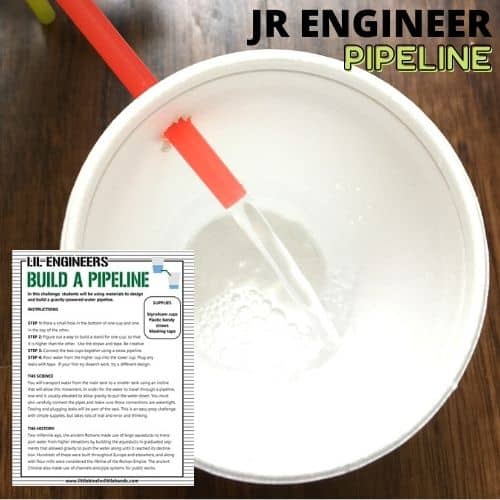
Water Upward
Fill a glass with water and place a piece of cardboard on top. Hold the cardboard and glass firmly together, then quickly turn the glass upside down. The water will stay inside the glass due to air pressure, demonstrating the balance between gravity and air pressure.
Rolling Race
Set up a ramp using books or a board. Have kids release different objects (marbles, toy cars) from the top of the ramp and see which one reaches the bottom first. Discuss how gravity affects the speed of rolling objects. See how to set it up with toy cars , pumpkins , apples and plastic Easter eggs .

Gravity-Powered Pendulum Painting
Attach a small container with paint to the bottom of a pendulum (a string with a weight at the end). Set the pendulum in motion and observe how it creates unique patterns on a piece of paper beneath it.
Crumpled Paper Drop
Crumple two pieces of paper into balls, one larger and one smaller. Drop them both at the same time and discuss how their sizes and air resistance affect their falling speed.
Balancing Act
Have kids experiment with balancing different objects on their fingertips. Discuss how the weight and shape of objects affect their balance due to the force of gravity. Have fun balancing animal puppets , mobile of paper shapes , pumpkins , and paper apples .
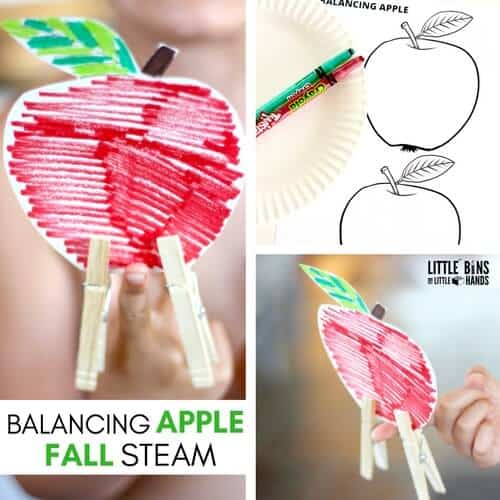
Egg Drop Challenge
Provide kids with materials like straws, rubber bands, tape, and newspapers. Challenge them to design a structure that will protect a raw egg when dropped from a certain height, demonstrating how objects experience less impact force when they have more time to slow down (larger parachutes or cushioning). See our egg drop ideas for younger and older students.
Water Wheel
Build a simple water wheel using a plastic container, a stick, and a paper cup. Place the water wheel under a steady stream of water and observe how gravity causes the wheel to turn. See how to build a simple water wheel here.
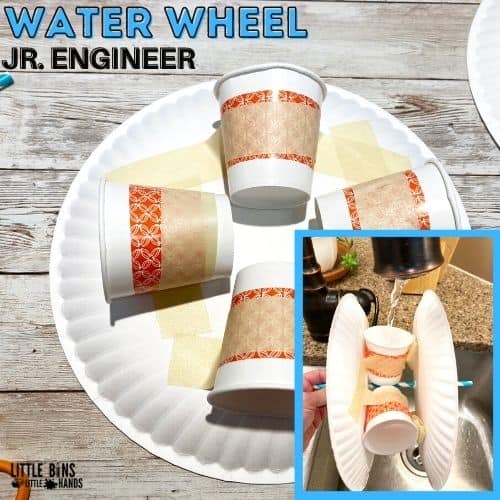
Have younger kiddos? Check out these fun gravity activities for preschool and kindergarten.
The Most Famous Gravity Experiment
Sir Isaac Newton is famous for many contributions to physics, and his experiments with gravity are among his most renowned works. One of the key experiments associated with Newton’s study of gravity is often called the “Newton’s Falling Apple,” which is a story rather than a controlled experiment.
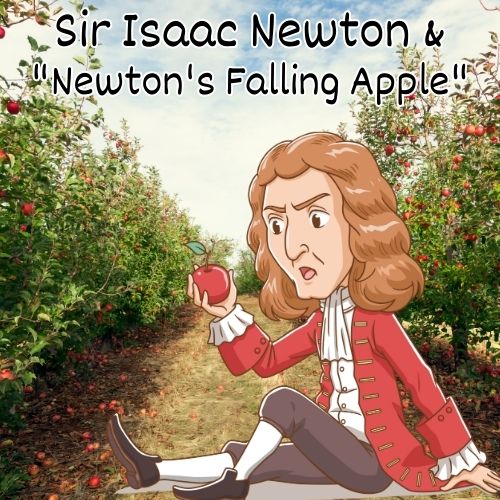
According to the legend, Newton was sitting under an apple tree in his garden when he saw an apple fall to the ground. This event got him thinking about the force that caused the apple to fall. Newton realized that the same force, gravity, was responsible for the apple’s fall and the motion of bodies in space like the Moon and planets.
Explore experiments that illustrate Newton’s Laws!
While this story is well-known, it’s important to note that it wasn’t a formal experiment. However, Newton conducted a series of experiments and observations to develop his laws of motion and the law of universal gravitation. These experiments and observations included:
- Prism Experiments: Newton’s experiments with prisms and light led to his groundbreaking work on optics, which is separate from gravity but an important part of his overall scientific contributions. See Newton’s color wheel spinner.
- Mathematical Calculations: Newton used mathematics to formulate his laws of motion and universal gravitation. He developed the mathematics of calculus to help describe and predict the behavior of objects under the influence of gravity.
- Kepler’s Laws: Newton built upon Johannes Kepler’s laws of planetary motion to develop his laws of universal gravitation. Kepler’s work was based on extensive astronomical observations.
So, while there isn’t a specific experiment directly related to the falling apple, Newton’s contributions to our understanding of gravity are based on a combination of observations, mathematical calculations, and experiments.
Have fun with physics! Check out our complete list of easy physics experiments.
Grab your FREE printable science worksheets!

Helpful Science Resources To Get You Started
Here are a few resources that will help you introduce science more effectively to your kiddos or students and feel confident yourself when presenting materials. You’ll find helpful free printables throughout.
- Best Science Practices (as it relates to the scientific method)
- Science Vocabulary
- 8 Science Books for Kids
- All About Scientists
- Science Supplies List
- Science Tools for Kids
- Join us in the Club
More Physical Science Activities
- Light Experiments
- Magnet Activities
- Simple Machine Projects
- Potential & Kinetic Energy
- Static Electricity
- Surface Tension Experiments

Printable Science Projects For Kids
If you’re looking to grab all of our printable science projects in one convenient place plus exclusive worksheets and bonuses like a STEAM Project pack, our Science Project Pack is what you need! Over 300+ Pages!
- 90+ classic science activities with journal pages, supply lists, set up and process, and science information. NEW! Activity-specific observation pages!
- Best science practices posters and our original science method process folders for extra alternatives!
- Be a Collector activities pack introduces kids to the world of making collections through the eyes of a scientist. What will they collect first?
- Know the Words Science vocabulary pack includes flashcards, crosswords, and word searches that illuminate keywords in the experiments!
- My science journal writing prompts explore what it means to be a scientist!!
- Bonus STEAM Project Pack: Art meets science with doable projects!
- Bonus Quick Grab Packs for Biology, Earth Science, Chemistry, and Physics.

Subscribe to receive a free 5-Day STEM Challenge Guide
~ projects to try now ~.

Rotate your device to experience this experiment
01 gravit y/.
Observations
How do celestial bodies warp the fabric of space-time and interact with each other?
ABOUT THIS EXPERIMENT
We tend think of gravity as a force of attraction, but it’s also been described as a curvature of space-time in the presence of mass. This National Science and Technology Medals Foundation interactive invites you to bend the fabric of space-time and observe the resulting gravitational forces. By adjusting the variables of mass, distance, and velocity, you can trigger orbits, collisions, and escape velocities in space.
The National Science and Technology Medals Foundation celebrates the amazing individuals who have won the highest science, technology, engineering, and mathematics award in the United States.
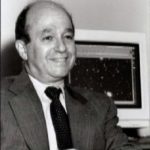
Jeremiah P. Ostriker
Studied the gravitational effects of dark matter.

John A. Wheeler
Popularized Einstein’s theory of relativity after WWII.

Edward Witten
Charted the topology of space-time.

Robert H. Dicke
Predicted the discovery of the Big Bang echo.
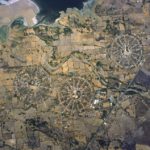
Allan R. Sandage
Discovered the first quasar.
See All Laureates in Theory & Foundations
Your universe has reached critical mass and collapsed. Fascinating!
Learn more about the pioneering scientists and thinkers behind this experiment at nationalmedals.org
Here are a few to check out:
- Skip to primary navigation
- Skip to main content
- Skip to primary sidebar

- FREE Experiments
- Kitchen Science
- Climate Change
- Egg Experiments
- Fairy Tale Science
- Edible Science
- Human Health
- Inspirational Women
- Forces and Motion
- Science Fair Projects
- STEM Challenges
- Science Sparks Books
- Contact Science Sparks
- Science Resources for Home and School
Ideas For Learning About Forces and Motion
May 30, 2020 By Emma Vanstone 7 Comments
Forces are all around us and affect everything we do. With that in mind, I’ve put together a collection of ideas for learning about forces and motion with fun forces and motion experiments for everyone, from preschoolers to grown-ups. There are friction experiments, gravity experiments, air resistance experiments, and lots more! Each activity is easy to set up and works well as a science project for home or school.
If you’re looking for a book full of force experiments, This IS Rocket Science might be just what you’re looking for! It contains SEVENTY experiments all about the forces involved in space travel!
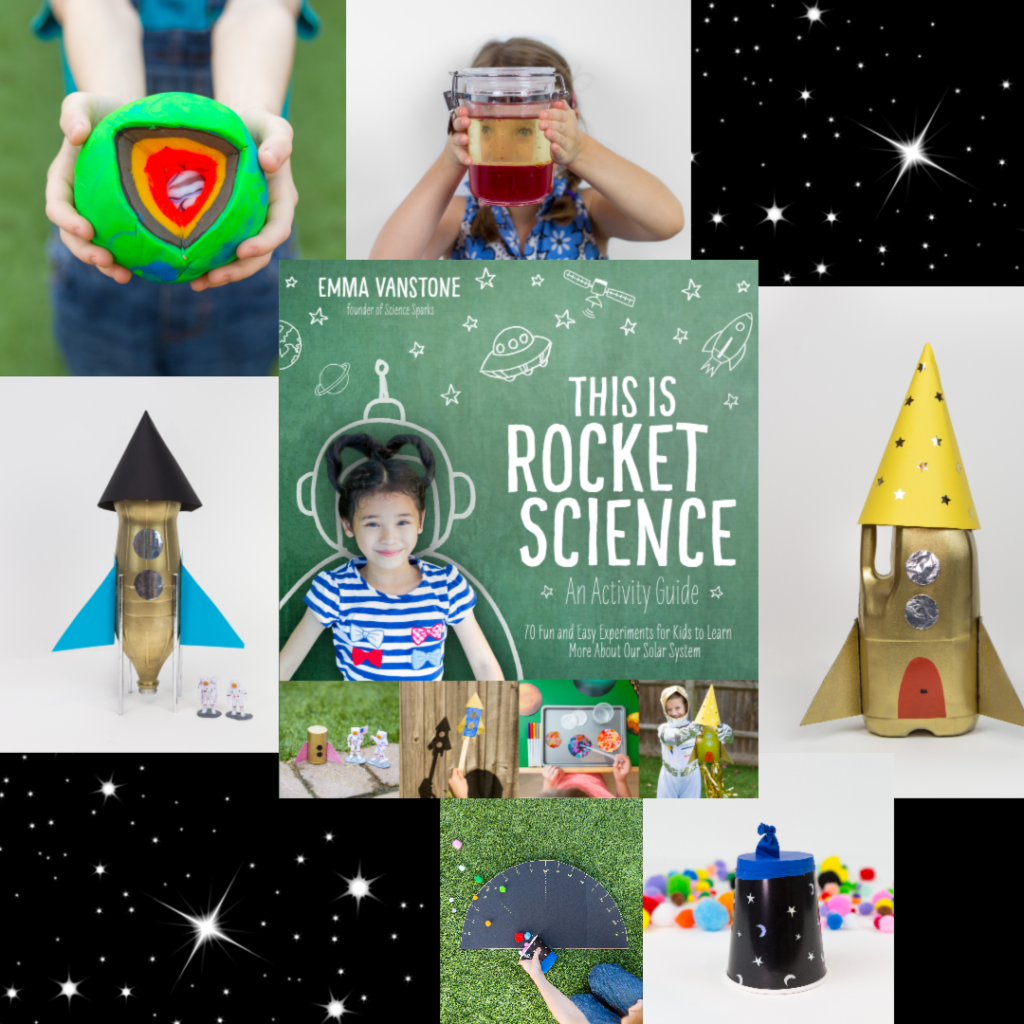
Let’s start with some basics.
Forces and Motion – What is a force?
A force is a push or a pull. Forces can make objects move or stop, speed them up or slow them down. If you push a toy car it moves, if you push it harder it moves faster. Forces can also make objects change direction or shape.
A lighter object needs less force to move than a heavier object. For example you could push an empty box easily, but a filled box would be harder, it would need more force to move.
If you give a toy car a push what happens? It speeds up and then slows down. The reason it slows down is because of two forces, air resistance and friction.
Air resistance is air pushing on a moving object which slows it down.
Friction is the force between two objects when you rub them together. Try rubbing your hands together? Do they get hot? You feel the friction between your hands as heat.
Air resistance and friction take time to slow an object down, if you want an object to stop quickly you need to apply further force, for example a brake on a bike.
Other examples of forces are magnetism, gravity and air pressure.
Over the years we’ve completed lots of forces experiments on Science Sparks, here are the best ones.
Learn about simple push and pull forces in this easy activity.
Friction Experiments for Kids
What is friction.
Friction tries to stop objects sliding past each other. Friction allows things to start and stop moving and slows them down.
Imagine sliding two strips of ribbon over each other and then think how hard it would be with two velcro strips. There is more friction between the velcro strips than the ribbon. The amount of friction between two objects depends on what the objects are made from. The rougher the surface the more friction is produced, this is why rockets are streamlined!
Friction Experiments
Find out why you slip and slide more on smooth surfaces than rougher surfaces with this slipping and sliding activity. Do be careful not to fall over though.

A toy zip line is the garden is a great way to learn about friction and fun science project too!
Discover why we salt/grit icy roads in winter.
Investigate which material would make the best ice hockey puck . We want to reduce friction for a good puck as it needs to move quickly and cleanly across the ice.
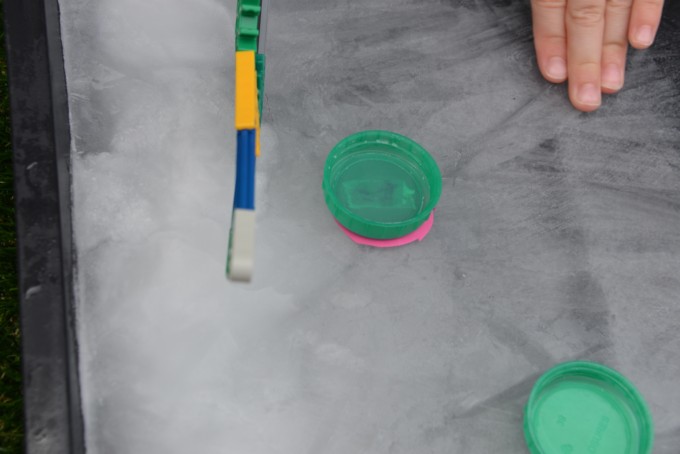
Learn about reducing friction with this easy Hovercraft

Gravity Experiments for kids
A film canister rocket is a great demonstration of lots of different forces, but it falls back to the ground thanks to gravity.
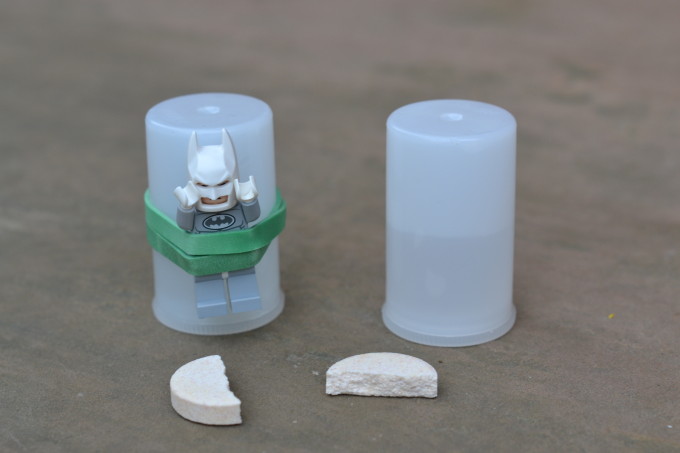
Water powered bottle rockets are another fantastic example of gravity and lots of other forces too!
Discover a cool science trick to defy gravity using magnets.
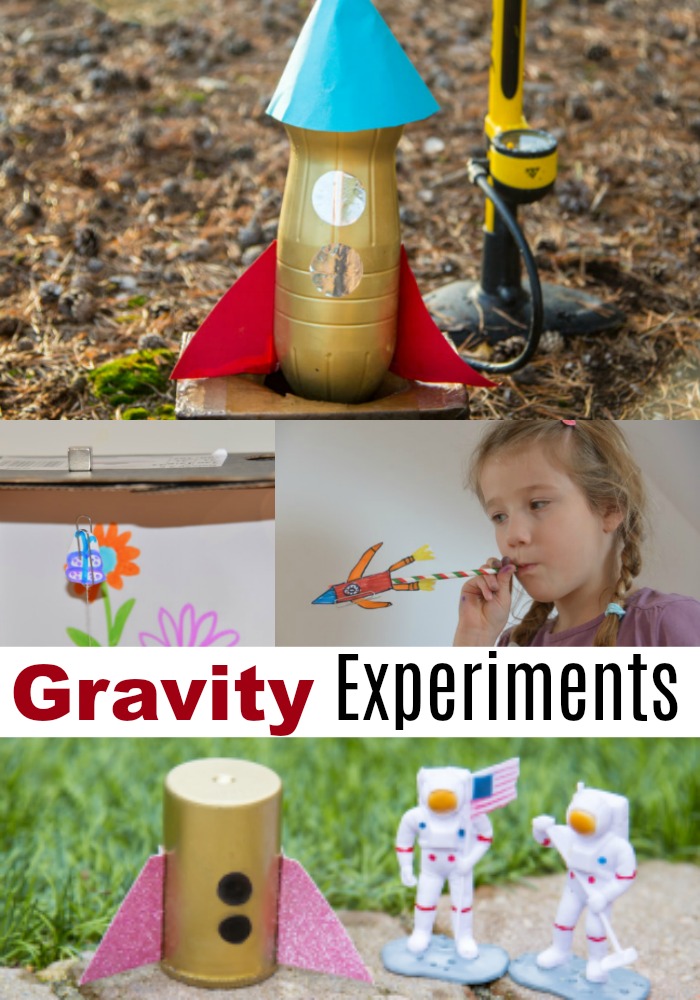
Design and build straw rockets and launch at different angles to investigate how the flight trajectory changes.
For younger children, try this fun gravity activity from Inspiration Laboratories .

Making vehicles move – science experiments
We used carbon dioxide released from a baking soda and vinegar reaction to power a bottle boat .
Store up energy in an elastic band to make a cotton reel car move.
Slightly more simple and much more powerful is our balloon powered car .
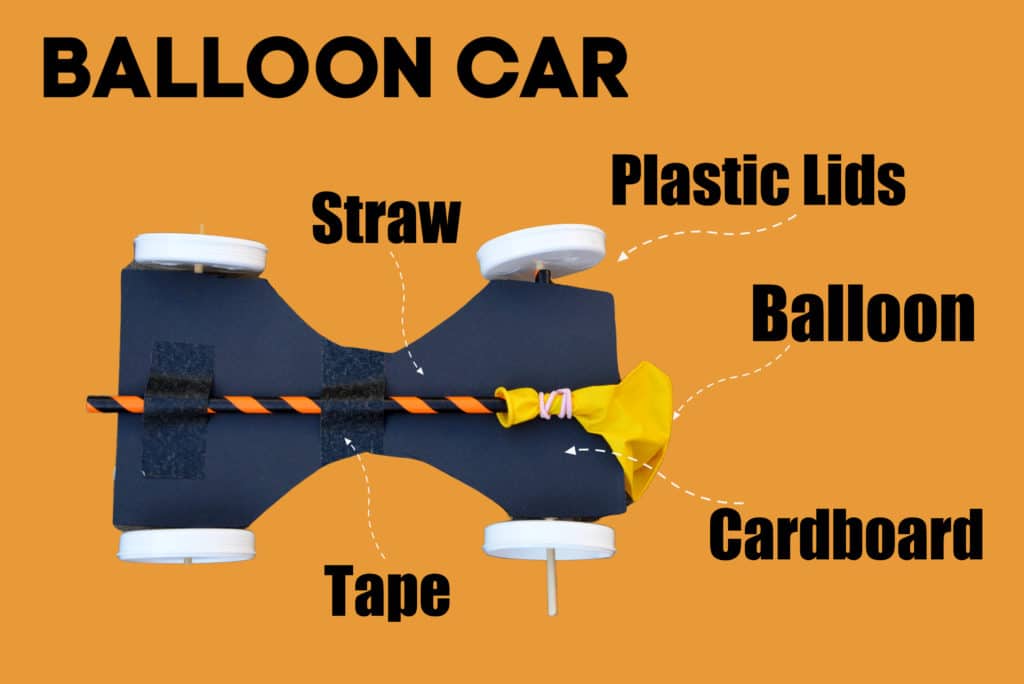
Red Ted Art made a fun elastic powered tugboat which moves using the energy stored when you wind up an elastic band.
Magnet Experiments for Kids
Make an easy magnet maze with cardboard or even a LEGO maze .
Build some easy magnet powered cars or a magnet powered boat.
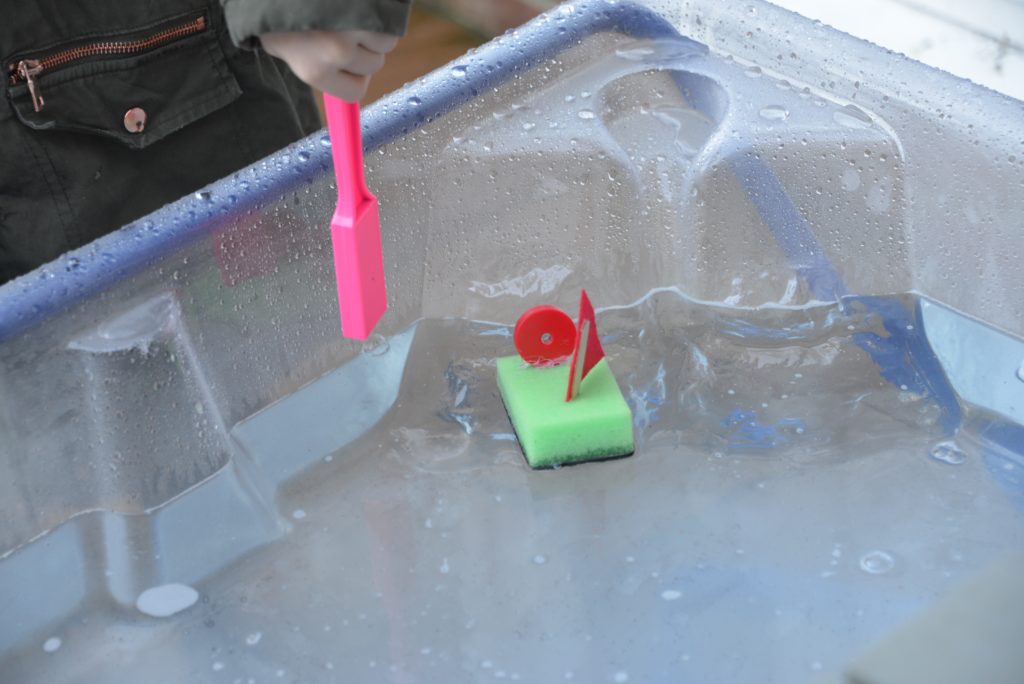
How about a magnet sensory bottle ?
Air Resistance Experiments for Kids
Explore gravity and air resistance with these simple paper spinners .
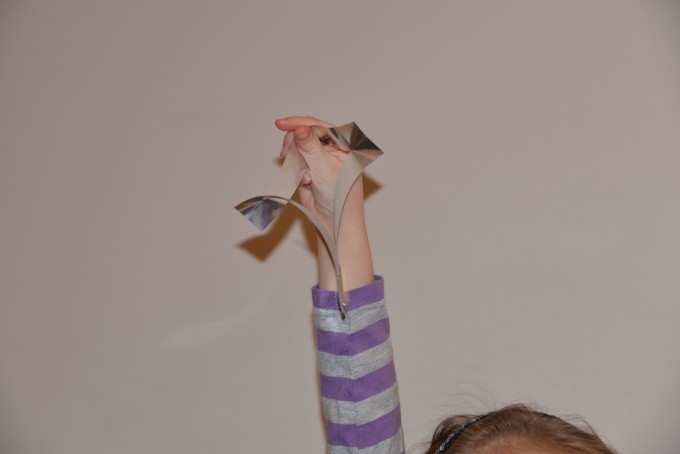
Make a parachute , can you save an egg?
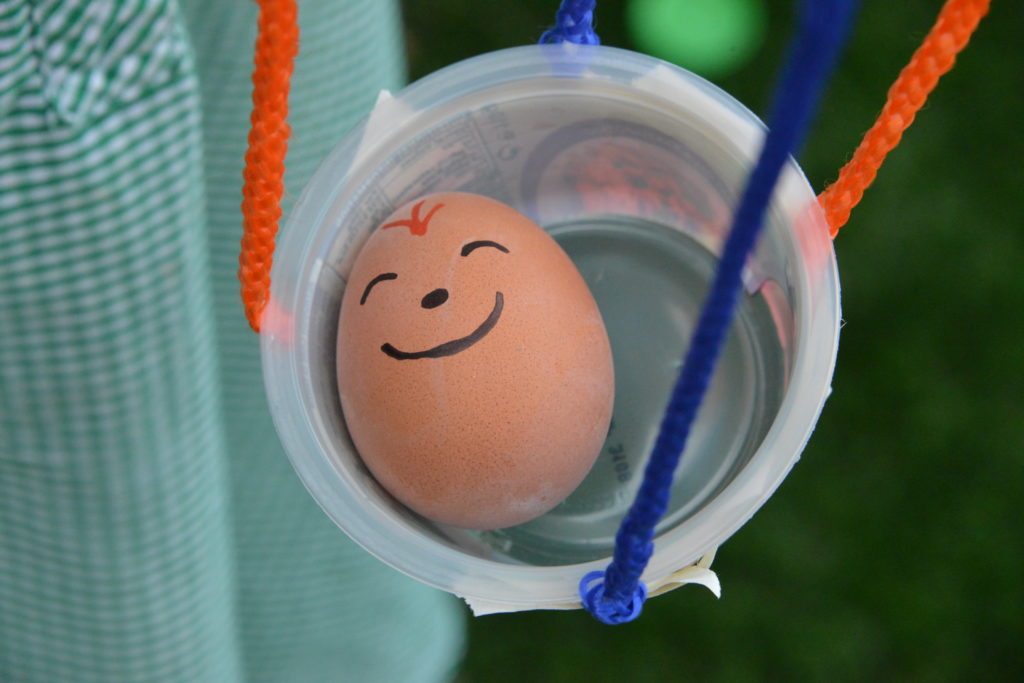
Air Pressure Experiments
Watch a boiled egg drop into a bottle with a little science magic.
Make a bottle rocket . Remember you need lots of space for this one as the rocket shoots up quickly and very high!
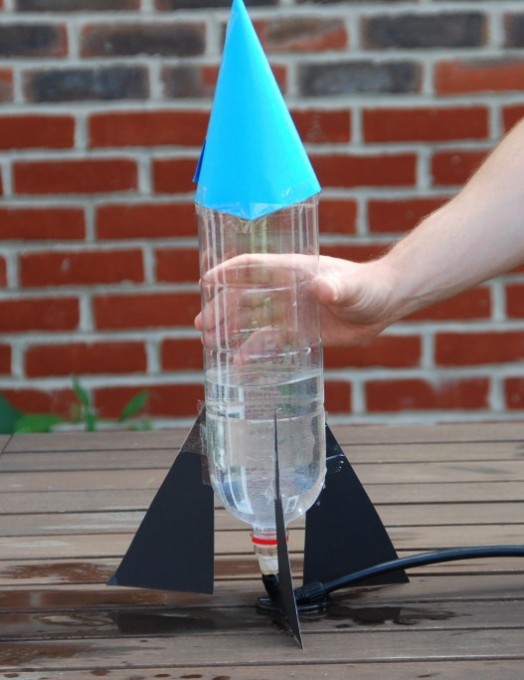
Watch water rise with a cool air pressure experiment .
Pop the lid off a bottle with these coin poppers .
Make these shooters and explore trajectory and aerodynamics .
How about a film canister rocket ? These are great fun, always work, and fly with a pop!

More ideas for learning about forces and motion
Make a simple stomp rocket !
Try this easy inertia experiment where an object drops straight down into a glass!
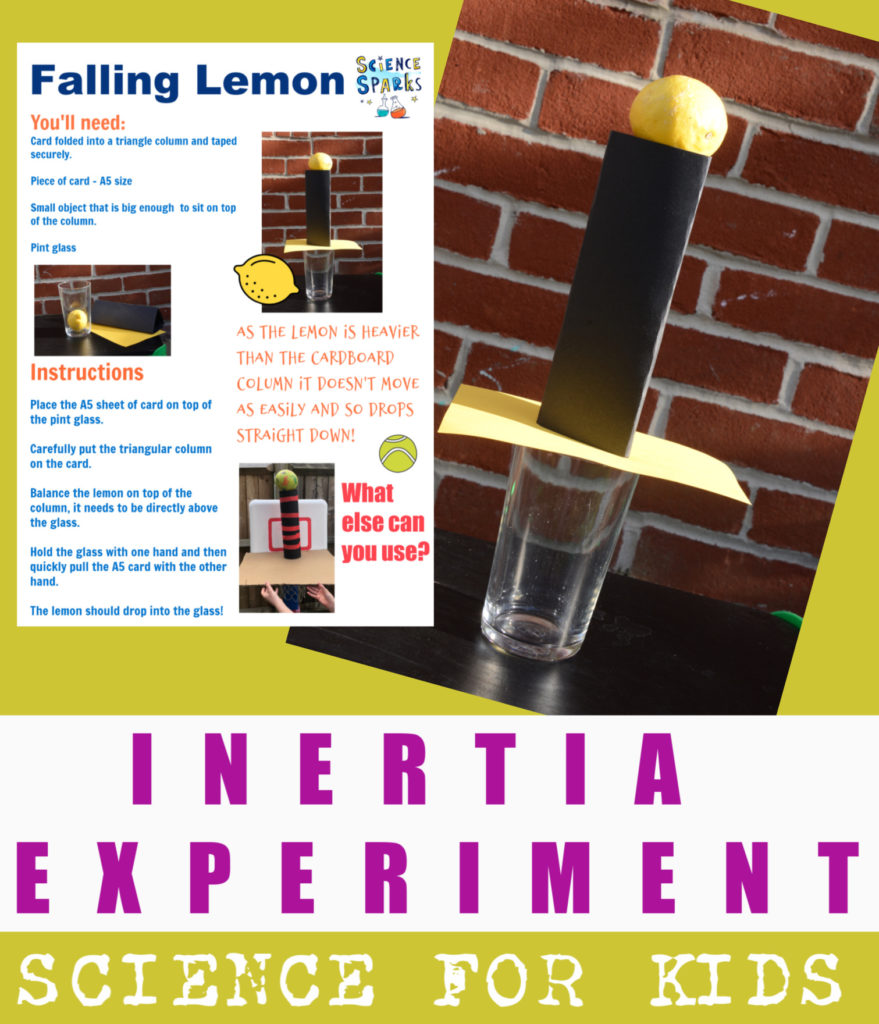
Learn about kinetic energy with a homemade slingshot or lollystick catapult .
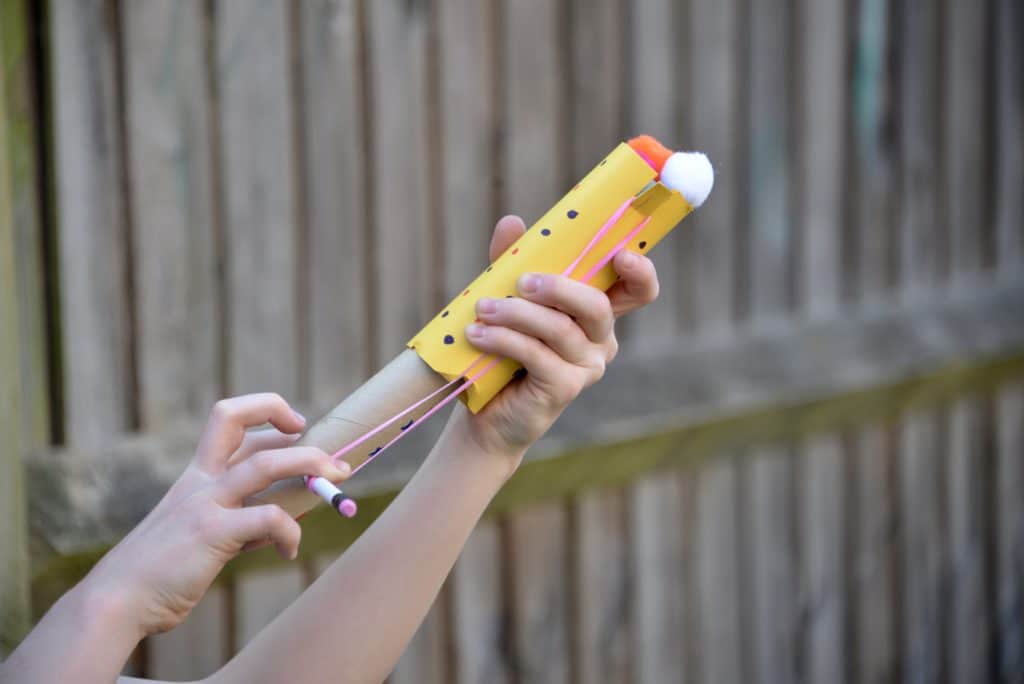
Drop water balloons filled with paint and compare splatter patterns from different heights.

Explore energy and ‘bouncy-ness’ with some balls and different surfaces.
Try this milk jug rocket craft and experiment from Red Ted Art.
Find out how you can stand on a paper cup without it breaking .
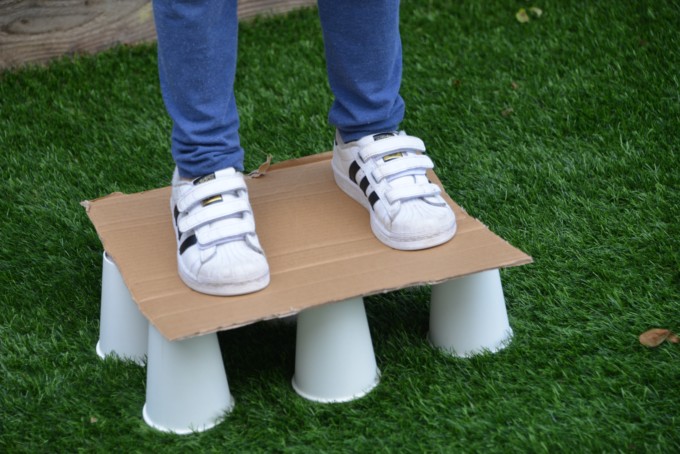
Why do you get dizzy on a roundabout ? It’s all about the forces.
You could investigate the force needed to break an eggshell .

Finally, do you know why a balloon makes a funny noise when you let it go?
Finally, learn all about Newton’s famous Laws of Motion with even more brilliant science experiments for learning about forces.
We’ll be adding to this list constantly, so do keep popping back for more great ideas for forces and motion experiments for kids .
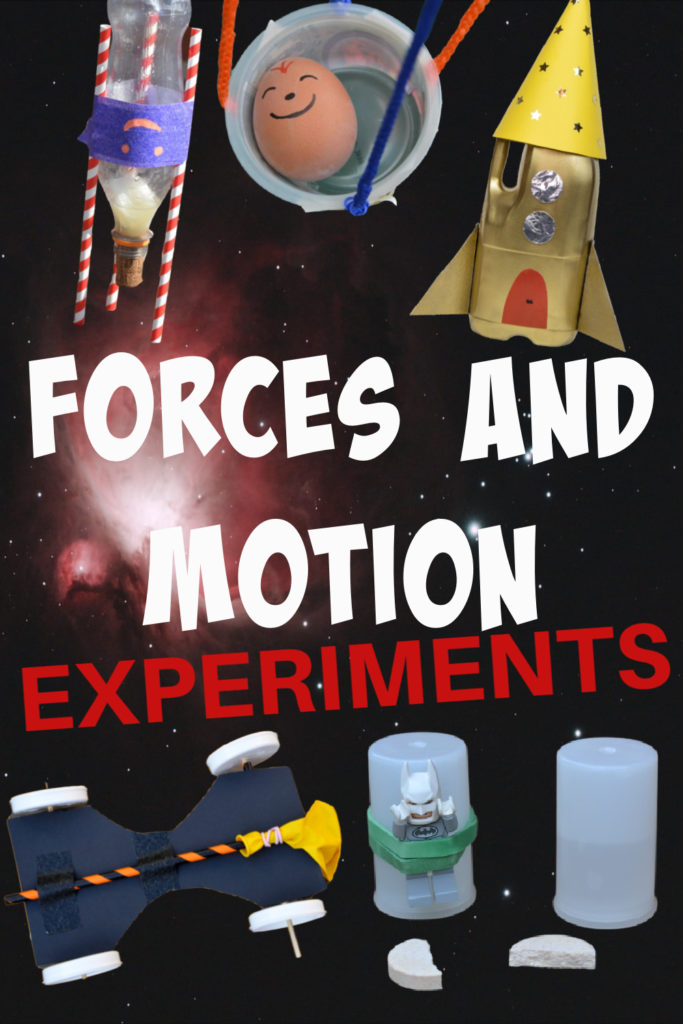
affiliate links
Last Updated on April 19, 2024 by Emma Vanstone
Safety Notice
Science Sparks ( Wild Sparks Enterprises Ltd ) are not liable for the actions of activity of any person who uses the information in this resource or in any of the suggested further resources. Science Sparks assume no liability with regard to injuries or damage to property that may occur as a result of using the information and carrying out the practical activities contained in this resource or in any of the suggested further resources.
These activities are designed to be carried out by children working with a parent, guardian or other appropriate adult. The adult involved is fully responsible for ensuring that the activities are carried out safely.
Reader Interactions
January 29, 2014 at 9:40 pm
Love this collection, Emma!
March 03, 2015 at 7:19 pm
Wow! I love these ideas, they are fantastic!! I will be definitely be featuring these ideas on my latest post (www.thegrade3teacher.com). Thanks for sharing!
March 04, 2016 at 12:51 pm
Thanks for these ideas… It will help my kids learn about forces. Great input
July 27, 2016 at 2:29 am
Wow! What a great collection of activities that show various engineering concepts!
April 03, 2017 at 8:10 pm
Thank you everyone if you have a ? Email me @ [email protected]
April 05, 2018 at 10:32 pm
-such good ideas on forces.I so have to try one.I like the one with the ballon and car…
April 05, 2018 at 10:39 pm
I am so going to so try this with my kids for a science project.Im going to tell more people about this app.
Leave a Reply Cancel reply
Your email address will not be published. Required fields are marked *
- Skip to primary navigation
- Skip to main content
- Skip to primary sidebar
Teaching Expertise
- Classroom Ideas
- Teacher’s Life
- Deals & Shopping
- Privacy Policy
Gravity Activities For Middle School: Experiments, Puzzles, Challenges, And Investigation
January 28, 2024 // by Cassie Caroll
The concept of gravity becomes much more accessible through hands-on materials and activities. When your student is ready to learn about gravitational forces, the laws of motion, and air resistance, an engaging demonstration of these abstract ideas can make instruction that much more effective. With some simple materials, you can recreate these demonstrations of gravity in the comfort of your own home. Here are some of our favorite gravity activities that are instructive, entertaining, and user-friendly!
Center of Gravity Activities
1. center of gravity experiment.
Jumpstart your learner by challenging them to a seemingly impossible challenge: balancing a craft stick on top of a chopstick. For this activity, you’ll need a couple of clothespins, a chopstick, a craft stick, and some pipe cleaner. By the end, your student will begin to visualize the center of gravity.
Learn More: Rookie Parenting
2. Gravity Puzzle
We’ll admit, at first this activity seems far more complex than necessary. To simplify the setup process, start the gravity puzzle video at 2:53 for easier design. This experiment with a balance point and center of gravity will quickly become a favorite magic trick, too!
Learn More: YouTube
3. Uncanny Cancan
Ever seen a soda can do ballet? Now is your chance with this center of gravity lab! We love this activity because it can be as quick or lengthy as you’d like depending on the number of trials you perform, and all you need is an empty can and some water!
Learn More: ABC
Velocity and Free Fall Activities
4. falling rhythm.
This experiment is relatively simple in execution, but more complex in analysis. As your learner listens to the rhythm of the falling weights, consider contextualizing their observations with the basic ideas of velocity, distance vs. time, and acceleration.
Learn More: Exploratorium
5. Egg Drop Soup
This egg drop trick is another experiment that can begin with a challenge: how do you drop an egg into a glass of water without touching either one? This demonstration gives learners the chance to better understand balanced and unbalanced forces in action.
Learn More: Generation Genius
6. Origami Science
Understanding the balance between gravity and air resistance can be quite simple with some simple materials and a bit of origami. This activity lends itself well to opportunities to make a claim with evidence as you modify your origami drop.
Learn More: Little Bins for Little Hands
Gravitational Phenomenon Demonstrations
7. gravity defiance.
Although this experiment is demonstrated with younger children, this can be an excellent lesson opener to introduce the role of gravity and gravitational pull. Challenge your student to experiment with distance and magnetic strength by trying different positioning of the magnet and clips!
Learn More: Buggy and Buddy
8. Air Pressure and Water Weight
To demonstrate the concept of air pressure, all you need is a glass of water and a piece of paper! We especially love how this resource provides a thorough lesson plan and a Powerpoint with notes to complement the experiment.
Learn More: Cool Science Experiments HQ
9. $20 Challenge
We promise, no money will be lost in this experiment. But if you’d like to play it safe, you can always make it a $1 challenge! Test your students’ dexterity and patience with this fun experiment in gravitational pull.
Learn More: Thirteen
10. Centripetal Force Fun
This engaging video shows multiple gravity-defying experiments to try, but our favorite begins at minute 4:15. By swinging your cup or bottle at a constant rate, the water will remain in the vessel, seemingly defying gravity! Nanogirl’s explanation helps contextualize this phenomenon for your learner.
Learn More: Nanogirl STEM Activities for Kids
Gravity on Earth and Beyond Activities
11. out of this world gravity investigation.
Help your learner get a grip on gravity by walking them through this gravitational exploration of the greater solar system. This activity provides the procedure, worksheets, and recommended extensions and modifications. In conjunction, have your student take a virtual tour of the ISS to build some background knowledge.
Learn More: ESA Multimedia and CASIS Academy
12. Build a Model for Gravity in Space
When viewing a diagram of our solar system, it is easy to view the planets as mere distant objects, however, this demonstration allows students to better understand the definition of gravity as it pertains to our galaxy. Grab some chairs, billiard balls, and some stretchy material, for this rewarding demonstration!
Learn More: iTeachly
13. Elevator Ride to Space
Far from Willy Wonka’s glass elevator, our everyday elevators are excellent demonstrations of gravitational interactions. This activity allows learners to better understand how the effects of gravity become seemingly aberrant in space without leaving Earth! We recommend bringing along a towel in case of any spillage!
Learn More: Education
14. “Rocket” Science
I guess this hands-on gravitational force activity is indeed “rocket science!” This rocket-building experiment works with chemical reactions, increases in velocity, rate of acceleration, and the laws of motion. We recommend this project as either a concluding activity or an extension into more complex concepts.
Learn More: Ward’s World
15. Magnetic Learning
Need a quick opener or closer to a lesson? This gravity and magnetism activity can be a fun demonstration of magnetic fields and gravitational force. Be sure to read the notes in this activity to extend this experiment in different ways.

Science Experiments for Kids: Learning About Gravity
Up, up, and away: fun and easy gravity experiments for kids.
Table of Contents
Amaze your friends and family with a science show. Ask your audience to predict the outcome of each of these easy science experiments about gravity .
All objects on Earth are pulled toward the planet’s center by the force of gravity. Gravity is the force that makes a basketball swish through a hoop. Gravity is the force that makes your glass of juice crash to the floor when it slips out of your hand. Gravity is the force that keeps your feet on the ground when you go for a walk. As Judy Breckenridge points out in Simple Physics Experiments with Everyday Materials, “Without gravity we would all float off into outer space.” Hooray for gravity!
In this post, we will share some of the best gravity experiments that you can do with your kids, using everyday materials that you can find at home. From balloon rockets to pendulum painting, these experiments will keep your kids entertained and educated all at once. Get ready to inspire your little ones with the wonder of science!
Quick Introduction to Gravity
Gravity is the force by which a planet or other body draws objects toward its center. The force of gravity keeps all of the planets in orbit around the sun . Earth’s gravity is what keeps you on the ground and what makes things fall. It’s what holds the atmosphere in place so we can breathe and it’s what allows us to use rockets to launch into space.
Gravity is a fundamental force of nature that is present everywhere in the universe. It is what gives objects weight and is responsible for the motion of planets, stars, and galaxies. Without gravity, the universe as we know it would not exist.
Understanding the basics of gravity is important for many areas of science, including physics, astronomy, and engineering. By conducting simple gravity experiments, kids can learn about this fascinating force of nature in a fun and engaging way. From exploring how gravity affects different objects to create their own mini-gravity wells, there are many exciting experiments that kids can do to learn more about this fundamental force.
Science Experiment: Dropping objects of different weights
Experiment 1: Dropping objects of different weights is a classic gravity experiment that teaches kids about mass and gravity. All you need for this experiment are a few objects of different weights, like a feather, a rock, and a rubber ball, and a place to drop them from, like a balcony or a staircase.
Start by asking your child what they think will happen when they drop each object. Will the heavier object fall faster or slower than the lighter object? Then, drop each object one by one and observe what happens.
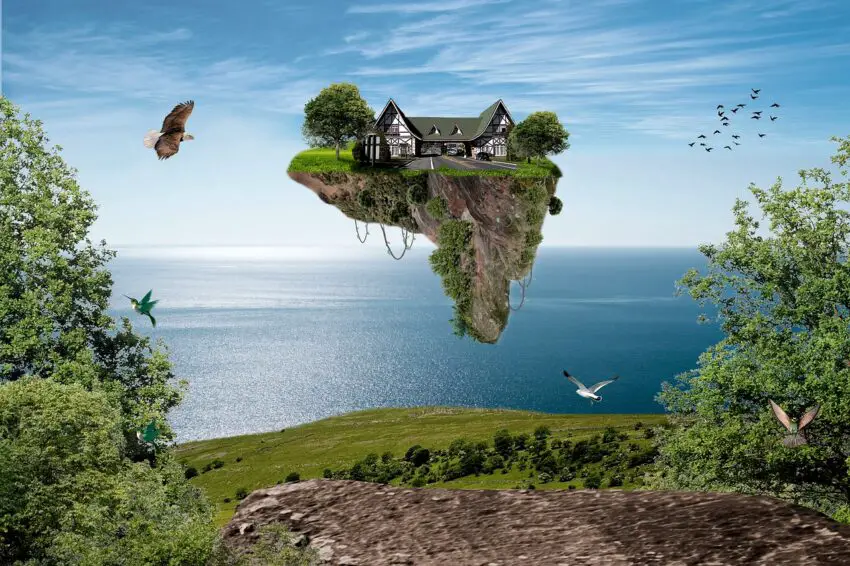
You’ll find that all objects fall at the same rate, regardless of their weight. This is because gravity pulls all objects towards the earth at the same acceleration rate , which is 9.8 meters per second squared. You can explain this to your child by saying that the earth’s gravity pulls all objects towards it with the same force, so they all fall at the same rate.
You can also ask your child to try dropping the objects from different heights and see if that affects the way they fall. This will give them a better understanding of how gravity works and how it affects objects. This experiment is a great way to introduce your child to science and to help them understand the world around them.
Science Experiment: Making a gravity well
A gravity well is a concept that is used to represent the way gravity affects the path of objects in space. In this experiment, your child will learn how gravity works by creating a visual representation of a gravity well.
Materials needed:
- A large, flat container (such as a baking tray)
- A small ball (such as a marble)
- Food coloring (optional)
Instructions:
- Pour a thin layer of flour into the flat container, making sure it covers the entire surface.
- Place the small ball in the center of the container.
- If desired, add a few drops of food coloring to the flour around the ball.
- Use your fingers to gently press down on the flour around the ball, creating a depression in the flour. The depression should be deepest around the ball and gradually become shallower as you move away from the ball.
- Observe how the ball remains in the center of the depression you created in the flour. This is because the flour represents the fabric of space-time and the ball is pulled towards the center by the force of gravity.
To take the experiment further, you can try adding more balls to the container and observe how they behave differently depending on their mass and distance from the center of gravity well. This experiment is a great way to introduce your child to the fascinating concept of gravity and spark their curiosity about the world around them.
Science Experiment: Magnets to simulate gravity
Using magnets to simulate gravitational pull can be a fun and interactive way to teach kids about gravity. In this experiment, you’ll need a few simple materials such as a magnet, paper clips, and a thin piece of string.
First, tie the string to the magnet and then attach a few paper clips to the other end of the string. Next, hold the magnet above one of the paper clips and release it. You’ll notice that the paper clip is attracted to the magnet and will follow it as it falls. This is similar to how gravity works, as objects with more mass are attracted to each other.
You can also use this experiment to show how different objects with varying masses will be affected by gravity. Try attaching different objects to the string, such as a feather, a coin, and a small toy car. You’ll notice that the magnet has a stronger pull on the coin and car due to their greater mass, while the feather will not be affected as much because it has less mass.
This experiment is a great way to introduce kids to the concept of gravity in a fun and interactive way. It can also be a starting point for further discussions about the laws of physics and the universe around us.
Science Experiment: Making a simple pendulum
Making a simple pendulum is a fun and easy way to learn about gravity and motion. For this experiment, you will need a few simple materials:
- A piece of string or thread
- A small weight, such as a paperclip or washer
- A sturdy surface to attach the string
To make your pendulum, tie the string around your weight and attach the other end to your sturdy surface. You can use a table, a chair, or any other surface that won’t move around too much.
Once your pendulum is set up, give it a gentle push to set it swinging. Watch how it moves back and forth, and notice how the speed and direction of the pendulum change.
To make your experiment even more fun, try changing the length of the string or the weight of the pendulum. How does this affect the way the pendulum moves? Can you predict how the pendulum will behave based on these changes?
Making a simple pendulum is a great way to introduce kids to the concept of gravity and motion. Plus, it’s a fun and easy experiment that can be done with materials you probably already have at home.
Science Experiment: Gravity and Air Resistance
Before performing this experiment, show your audience a shoe and a flat piece of notebook or copy paper. Explain that you will be dropping both objects from the same height. Then ask your audience these questions:
- Who thinks the shoe will hit the floor first?
- Who thinks the paper will hit the floor first?
- Who thinks both objects will hit the floor at the same time?
Experiment:
- Hold the shoe in one hand and the paper in the other.
- Hold both objects high in front of you at equal heights.
- Release both objects at the same time.
Observation: The shoe hits the floor first.
Explanation: Because of the paper’s shape, its fall is slowed by air pushing up against its under-surface – this slowing effect is called air resistance.
Science Experiment: Effect of Gravity on Plant Growth
One of the most interesting aspects of gravity is its effect on living organisms. In this experiment, we’ll be looking at how gravity affects plant growth.
To start, you’ll need to gather some materials. You’ll need:
- 2 identical plants
- 2 identical pots
- Begin by filling both pots with soil and planting one of your plants in each pot.
- Water them both thoroughly and place them side by side in a sunny location.
- Now comes the fun part. Take one of the pots and place it on its side. This will cause the plant inside to be growing at a 90-degree angle to the ground. Leave the other pot standing upright.
- Over the next few weeks, observe the growth of both plants. Measure their height using the ruler and take note of any other differences you can see.
What you should find is that the plant growing at a 90-degree angle to the ground will grow differently than the plant growing upright. This is because gravity plays an important role in how plants grow. The plant growing on its side will have to work harder to grow against the pull of gravity, resulting in a different growth pattern than the one growing normally.
This experiment is a great way to teach kids about the effects of gravity on living organisms and can lead to further discussions about how gravity affects everything from trees to humans. Have fun experimenting!
Science Experiment: Gravity and Weight
Before performing this experiment, show your audience the shoe and the piece of paper crumpled into a ball. Explain that you will be dropping both objects from the same height. Then ask your audience these questions:
- Who thinks the paper ball will hit the floor first?
- Hold the shoe in one hand and the paper ball in the other.
Observation: The shoe and the paper ball hit the floor at the same time.
Explanation: Even though the earth exerts more pull on a heavier object, a lighter object experiences a greater degree of acceleration, meaning that it moves at a greater speed. Consequently, objects of different weights fall at the same rate when other forces such as air resistance are not a factor.
Science Experiment: Center of Gravity
Now it’s time for audience participation in your science show. Ask for volunteers for each of these exercises involving the center of gravity:
Pick up a penny
Ask a volunteer to stand against a wall with his feet together, heels pressed against the wall. Place a penny about one foot away on the floor in front of him. Ask him to pick up the penny without moving his feet or bending his knees. Can he do it?
Lift your left foot
Ask a volunteer to stand with her right side against a wall, pressing her right foot and cheek against it. Instruct her to lift her left foot off the floor. Can she do it?
Jump forward
Ask a volunteer to bend forward and grab his toes, keeping his knees slightly bent. Tell him to jump forward without letting go of his toes. Can he do it?
Ask a volunteer to sit in a straight-backed chair. Tell her to keep her back straight, her feet flat on the floor, and her arms folded across her chest. Then ask her to stand up. Can she do it?
Observation: Because all of these tasks restrict the center of gravity, it’s almost impossible for a person to perform any of them.
Explanation: As far as gravity is concerned, the weight of an object is concentrated at a single center point. The center of gravity for an object with a regular shape – the Earth, for example – is located at its geometric center. However, in irregularly shaped objects – the human body , for instance – the center of gravity moves around. If you try to shift too far away from your center of gravity, you’ll lose your balance.
Share Fun Science Experiments With Family and Friends
Learning new things about the world around you is fun and exciting. It’s even more fun when you share your discoveries with your family and friends. Gravity is just one of the interesting forces of nature – there are many more to explore and share.
Final thoughts on teaching kids about gravity
Gravity is a fascinating concept that has been studied and explored by scientists for centuries. Teaching kids about gravity can be a fun and engaging way to introduce them to the wonders of science and the natural world around them.
By conducting simple experiments and activities, kids can learn about the basic principles of gravity and how it affects the world around us. From dropping objects of different weights to observing how objects fall at the same rate, there are endless ways to explore this fascinating force.
Not only can teaching kids about gravity be fun, but it can also help to develop their critical thinking skills, problem-solving abilities, and scientific knowledge. By encouraging kids to ask questions and explore the world around them, we can inspire a love of learning and an appreciation for science that can last a lifetime.
Teaching kids about gravity can be a fun and rewarding experience for both children and adults alike. By providing opportunities for hands-on exploration and discovery, we can help kids develop a lifelong love of science and learning. So, let’s get started and see where the wonders of gravity take us!
- Bardhan-Quallen, Sudipta. Championship Science Fair Projects . NY: Sterling Publishing, 2004.
- Breckenridge, Judy. Simple Physics Experiments with Everyday Materials . NY: Sterling Publishing, 1993.
- Cobb, Vicki. Bet You Can’t! NY: Lothrop, Lee & Shepard Books, 1980.
Leave a Comment Cancel reply
You must be logged in to post a comment.

IMAGES
VIDEO